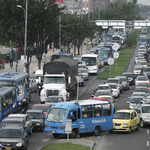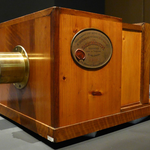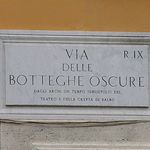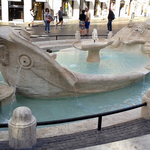Trastevere
The word is the adjustmen from the Latin exspression "trans tibirim" (beyond the Tevere).
The Roman quarter on the right bank of the Tevere consists of the plain between the river and Gianicolo to the south from Città Leonina.
It corresponds to the XIVth area of the Augustus' division. During the Middle Ages it was different from the rest of the town and joined to the Tiberina Island in the Vatican City. In the XIII and XIV centuries this area was united to the town and became the XIIIth area.
Then it extended up to the ancient Veiente river bank where the Etruscans of Porsenna encamped against Rome. Here the tradition put the heroic episodes of Orazio Coclide, of Muzio Scevola and young Clelia. Here in the Middle Ages the barons were recruiting their armies.
Between the Roman quarters it is considered to be "the most roman of Rome" by its origin and by the nature of its inhabitants. This nature expresses itself in the monuments, in the town planning, in the traditions of the inhabitants. It remained to be authentic and preserves better the aspects of the Roman epoch, especially of the Papal Rome.
Yet since the time of Ceasar up to the Middle Ages this area of Rome was inhabited by "strangers", for example by the sailors of Ravenna who were used to pull the tent on Colosseo, for to protect the spectators from the sun.
The traders from the East disembarked here in the disappeared port of Ripa Grande where the sailing-ships from the sea of Rome were coming in.
One could meet here the hebrews in search of a friendly earth, the pilgrims who were docking near Isola Tiberina.
They were attracted by the commercial activity of the river harbour overcrowded by foreigners and Hebrews .The current flea market which takes place every Sunday in Porta Portese is nothing else but the perpetuation of the ancient trades. Others were in search of the medical aid in the hospitals and in search of numerous alms-houses.
Still today Trastevere is a goal for foreigners searching for the local colour. Many international snobs have found here their pied-a-terres.
The district preserves a clear Roman taste in the labyrinth of small streets, where in the pile of agglomerated old and modest houses one can notice the particular corners,
houses and medieval towers, the XIVth century cloister and a breathtaking view the same as of the Gianicolo.
For to provide a better link with the the Vatican, Bramante designed the Via della Lungara for the pope Giulio II, but only Rome in the epoch of a capital assailed the quiet compactness of the building with the Viale Trastevere and the Lungotevere.
Besides many churches in the quarter reconstructed mostly in the baroque period which often adds a lively touch to the town picture, many characteristic restaurants and open taverns, the famous hosteries where it is possible to taste authentic romanesque dishes and to relive especially in summer the atmosphere of old pleasant and arrogant Rome.
In the month of July the popular holiday Festa de' Noantri, takes place here for several following days. So inhabitants of the quarter with musics, songs, shows and fireworks participate in the holiday while the fine tables are laid in the open air.
Among the churches two ones deserve a particular attention:
Santa Cecilia in Trastevere is worth of noticing for its separated site, its eighteenth-century grace, the memories of the Saing, the mosaics of the apse and the very beautiful fresco of Cavallini in the enclosed convent. It was built up by the pope Pasquale I on the place of the martyrdom of the Saint martyrised under Marco Aurelio.
Santa Maria in Trastevere is situated in the bottom of its beautiful homonymous square, in the centre and in the heart of this populated quarter. It is not the most important of the area, but it is one of the most important of Rome and one of the most ancient in the world. Its construction was begun by the pope San Callisto I (217-222) and accomplished by the pope San Giulio I (337-352) then it was rebuilt by the pope Innocent II, Gregorio Papareschi (1130-1143). Afterwards the pope Clement XI (1702) and the pope Pious IX (1870) had intervented without undergoing substantial alterations.
According to the tradition the same day when Jesus was born in Bethlehem "a source of oil" gushed in the square that announced the Messiah and in this magic point, still indicated by a little round stone near the altar the church was realized which was also called Santa Maria Fons Olei.
In the center of the square there is a fountain which existed from Augustus time. In 1500 Bramante rebuilt it and moved it to the front of the church but Bernini in 1660 remade it putting back to its place where it stands now. The renaissance scenographic aspect of the fountain is in contrast with the ensemble of the quarter which glamour is in the "poor"architecture of its houses and the labyrinth of the plebeian streets which surround the square.
In the Piazza di Trastevere Vittorio De Sica shot the principal scene of the famous neorealistic film of 1948 "Thieves of the bikes".
The northern point of the quarter at the foot of Gianicolo is the Renaissance corner. The luxurious palazzo Corsini (the original seat of Galleria Nazionale d'Arte Antica) and particularly la Farnesina, the precious renaissance pearl as for its architecture as for its decoration of Raffaello and other great masters of the XVIth century.
The Piazza Trilussa which faces on the Lungotevere is worth to be mentioned. The square is linked to the Sixtus bridge rebuilt under Sixtus IV in 1473-75. It is the only thrown bridge over the river between the classical age and the year 1870 reusing more ancient passage. The square is adorned by the XVIth century fountain dell'Acqua Paola and with the statue of the great Roman poet.

 The records of Rome. Big numbers, not always enviable, for a big city.
The records of Rome. Big numbers, not always enviable, for a big city. New Phot-O-Matic section. To spend some time looking at photos (also) of Rome.
New Phot-O-Matic section. To spend some time looking at photos (also) of Rome. The administrative, urban, toponymic and imaginative subdivisions of Rome.
The administrative, urban, toponymic and imaginative subdivisions of Rome. Notice for tourists: in Rome you drink for free. Historical fountains and 'big noses'.
Notice for tourists: in Rome you drink for free. Historical fountains and 'big noses'. Free museums return on the first Sunday of the month.
Free museums return on the first Sunday of the month.